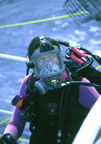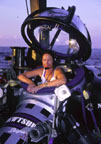|
|
Error processing SSI file |
Click on any image for an enlarged view
|
|
Sustainable Seas Expedition
|
Two DeepWorker training models were used for pilot training in the winter of 1998. The training was help at the MBARI click image for more...(Photo: Emma Hickerson- FGBNMS) |
|
|
Two DeepWorker 2000 submersibles, and a third, one of the trainer models, are lined up on the deck of the NOAA Vessel Ferrel click image for more... (Photo: Emma Hickerson- FGBNMS) |
|
|
Alex Score from Gray's Reef National Marine Sanctuary generously traveled to the Flower Gardens to lend a helping hand during the click image for more... (Photo: Emma Hickerson- FGBNMS) |
|
|
Dr. Peter Vize, the Principal Investigator/Pilot for the coral spawning project for SSE, instructs Capt. Ken McNeil in the finer point click image for more...(Photo: Frank and Joyce Burek) |
|
|
Dr. Sylvia Earle acts as data recorder for Principal Investigator/Pilot, Dr. Edie Widder, prior to a scheduled dual sub dive. click image for more... (Photo: Emma Hickerson- FGBNMS) |
|
|
With hopes high for the next days mission, the DeepWorker 2000's are strapped to the deck to keep them secure during the night. (Photo: Emma Hickerson- FGBNMS) |
|
|
During week one of the SSE mission at the Flower Gardens, a six-member team from National Geographic participated to document the click image for more... (Photo: Frank and Joyce Burek) |
|
|
After instruction by Richard Nordstrom on the use of the underwater communication masks, Sylvia and Emma made a click image for more... (Photo: Frank and Joyce Burek) |
|
|
Emma Hickerson dons the underwater communications mask prior to her dive with Sylvia Earle. They both wore this equipment during a dive with the National Geographic film crew. This enabled them to communicate with each other, the film crew underwater, and topside support people. (Photo: Frank and Joyce Burek) |
|
|
During the National Geographic/Sea Stories filming, Dr. Earle explains to Emma, the uses and benefits of deploying the DeepWorkers in the Sanctuary system. (Photo: Frank and Joyce Burek) |
|
|
Emma Hickerson prior to making a dive in DeepWorker 2000. Over the course of the mission, she was able to make 2 dives - one to 260' for close to 4 hours, and the second to 150' for around 3 hours. Both dives were click image for more... (Photo: Frank and Joyce Burek) |
|
|
When weather conditions halted sub operations, as well as SCUBA operations on the first night of coral spawning, click image for more... (Photo: Emma Hickerson- FGBNMS) |
|
|
Sylvia takes the opportunity to greet the Phantom S2 ROV while she conducts a night dive. (Photo: Emma Hickerson- FGBNMS) |
|
|
This picture illustrates the rough sea conditions we had during the most of the SSE mission at the Flower Gardens. The wash click image for more... (Photo: Emma Hickerson- FGBNMS) |
|
|
This web balloon fish is one of the hundreds fish surveyed both on SCUBA and during submersible dives. This animal has the click image for more... (Photo: Emma Hickerson- FGBNMS) |
|
|
The stoplight parrot fish is another fish found during SCUBA and submersible dives. (Photo: Emma Hickerson- FGBNMS) |
|
|
Also, the honeycomb cowfish was found during SCUBA and submersible dives. (Photo: Emma Hickerson- FGBNMS) |
|
|
And finally this yellowtail damsel fish was among the fish observed during the mission. (Photo: Emma Hickerson- FGBNMS) |
|
|
From left to right: Dave Lott, National Ocean Service - Special Projects Office (NOS-SPO), Dr. Sylvia Earle - National Geographic Society's Explore-in-Residence, click image for more... (Photo: Emma Hickerson- FGBNMS) |
|
|
Check out the movie of the big water spout - waterspout.mpg (14.5 Mb) (to download click once on file name and save to your hard drive) |
The day we returned to the Flower Gardens for leg two of the mission, we were greeted by a show of force by nature. For a period of approximately one hour, we were surrounded by water spouts. One of these spouts lasted for about 15 minutes, while weaving its way across the East Bank of the Sanctuary, passing close to both the M/V Fling and NOAA vessel Ferrel, before skirting the oil platform, HI389A. Here, Kip Evans, photo documents the largest of the water spouts from the Ferrel's bridge. (Photo: Emma Hickerson- FGBNMS) |
|
Zodiak/spouts - The Fling stayed tied to the mooring buoy ("on the hook"), while the Ferrel and it's RHIB boat motored out of harms way. (Photo: Emma Hickerson- FGBNMS) |
|
|
The small dot in the middle of the picture is the recreational dive vessel, M/V Fling, is sandwiched between two water spouts. (Photo: Emma Hickerson- FGBNMS) |
|
|
Sylvia encounters a 4 foot barracuda. Occasionally as many as 100 of these animals are seen schooling underneath the vessels click image for more... (Photo: Emma Hickerson- FGBNMS) |
|
|
Laddie Akins (REEF Director) takes time out from conducting a REEF fish survey as he swims with a manta ray (Manta birostris) click image for more ... (Photo: Emma Hickerson- FGBNMS) |
|
|
Sunsets are often the highlight of our days at sea, and during the SSE mission, this was no exception. (Photo: Emma Hickerson- FGBNMS) |
|
|
Darkness draws the day to a close, but work continues until the late hours on many a night. You don't realize, until night time does arrive, that you are sitting in the middle click image for more... (Photo: Emma Hickerson- FGBNMS) |


























